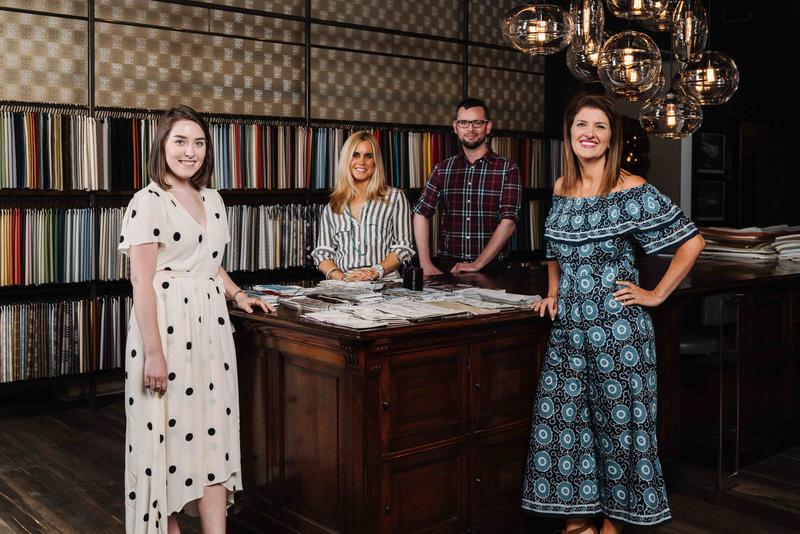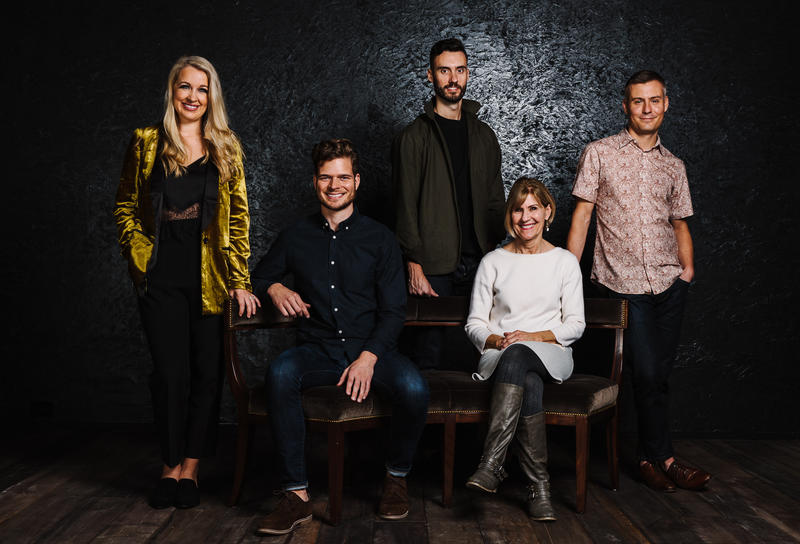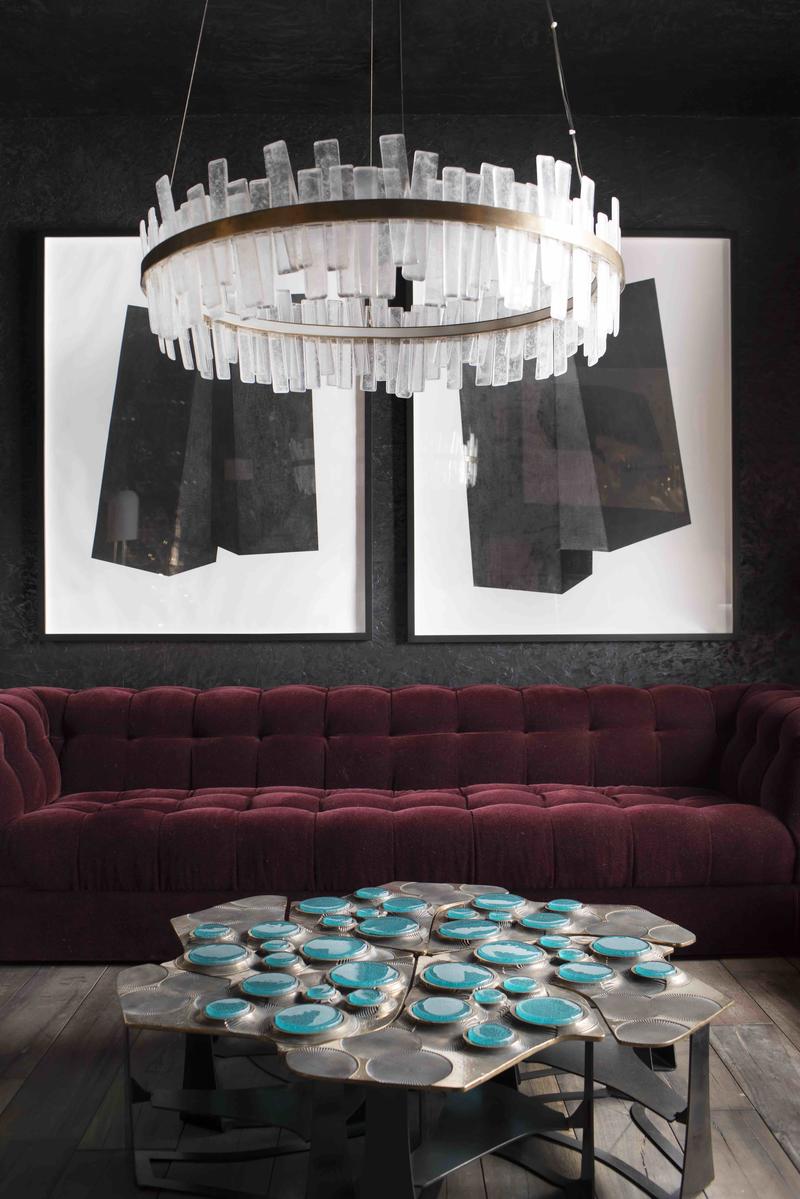Partnership in any endeavor entails a nuanced relationship, and shared showroom spaces are no exception. For the 9,000-square-foot showroom Holland & Sherry opened with R. Hughes in 2015 in the Atlanta Decorative Arts Center, acute attention to detail was in order to negotiate a look that expressed both brands’ points of view—a lesson Holland & Sherry vice president Daniel Waldron learned when $7,000 of embossed leather was ordered to cover a salesperson’s desk. (This part of the partnership, as Waldron tells it, wasn’t quite as easy to explain to the company’s CFO.)

“I always joke with [Ryan Hughes and Steven Leonard of R. Hughes] that their taste level is going to get me in trouble someday,” Waldron tells Business of Home. “But, really, it goes back to combining their exquisite design and merchandising abilities with our affinity for people and product. We don’t have a budget for this type of [luxury]—probably never will—but they make us look good.”
Early adopters of the co-branded showroom model, Holland & Sherry and R. Hughes found a way to collaborate without much of a road map. In a few short years, the two have developed a strategy that works for them, sharing not only square footage but sales teams that collaborate and cross-sell. Other industry players have taken note.
Last month, Thibaut, Arte and Egg & Dart unveiled a shared 3,000-square-foot showroom at the Pacific Design Center in Los Angeles. There are also two pairings opening in December in the New York Design Center: Designer Joe Lucas’s multi-line design showroom Harbinger will join forces with artisan wallpaper brand Fromental, and Brad Ford’s high-end design destination Fair will team up with rug maker Merida. With all these moves toward collaboration, are co-branded spaces becoming the new normal?
“I met Brad a few years ago and we really connected on our passion for makers and their importance in elevating the design industry,” Merida CEO and owner Catherine Connolly tells BOH. “When the trend is so powerfully moving toward cheaper, faster and more disposable, we are both moving toward more thoughtful, considered products that are as original as they are well made. We want the space to reflect the talent, creativity and depth of the makers, and we want to evoke curiosity among the designers to take the road less traveled, to discover for themselves how incredible these makers are and the benefits of buying things that are original.”
Connolly says Merida and Fair discussed the idea of partnering on a showroom for about a year. “We felt this was the right moment to join forces to celebrate makers and create more experiential spaces for designers and their clients. There is a strong undercurrent of people who appreciate the role of makers in elevating design and preserving culture through architecture and design.”
Ford believes both brands will reap the rewards of sharing resources and client data—and by complementing each other’s products. “At the end of the day, I’m hoping the real benefit will come to architects and designers who can come to one showroom and source a majority of their projects, from furnishings and lighting to rugs,” he tells BOH. “I’m a big fan of a one-stop shop.”

Both Holland & Sherry and R. Hughes have grown significantly since they first partnered on a smaller fabric showroom, in 2013, prior to the one they have now—something they hoped for, certainly, but of which they had no guarantee. Both sides agree it was bold to invest in the shared showroom model initially. Waldron says that though it was a risk early on, it became clear as time went by that it was the right move. “I think what made it successful was that each group was able to concentrate on what they do best,” says Waldron, who says that he would love to potentially open other locations with R. Hughes. “We sell textiles very well, they sell furniture and lighting very well. They really are two different animals and should be treated that way.”

Hughes explained that though each entered the partnership for different reasons, the two companies have been on the same page about their goals from the get-go. “When you have a big fabric house in your showroom, it drives more traffic,” he says. “It’s a lot easier for someone to come in and order three yards of fabric than for someone to come in and order a high-end sofa. But when customers come in, they may see a light fixture they like, and vice versa. Sometimes people come in for furniture, for example, and [then] they’ll ask if we have wool fabric to go with a specific chair.”
Though the sales teams are hired and managed independently, they often work together—both in the showroom and out. (Tomorrow, two representatives from each brand are headed to Jacksonville, Florida, to meet with a big client.) Holland & Sherry’s textiles are on every piece of upholstered furniture in the showroom; the teams cross-sell as much as they can; and neither brand advertises or sells the other’s competitors. And though Hughes doesn’t go out on as many sales calls himself since the brand’s expansion, Holland & Sherry’s ADAC showroom manager Laura Tilinski joins him on the appointments he does take.
When Hughes compared sales from the first showroom he opened in 2010 on the West Side of Atlanta to today’s sales from the ADAC suite, he was humbled to see how much the company had grown.
“It’s all about the idea that [brands] can do it better together than [alone],” says Hughes. “You surround yourself with people who are forward-thinking, you combine teams, and have bigger goals than you could on your own. You have to ask, ‘Why is it better? Why does it work?’ It works for us, so there’s no reason it couldn’t work for other people.”



























